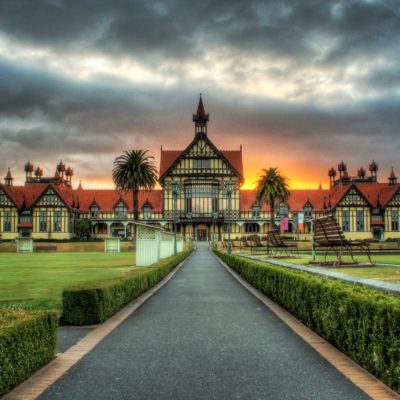Taonga to Storage
Taonga Safely Removed
In readiness for the construction phase of Rotorua Museum, all artworks, objects and taonga (treasures) that were on display in the many exhibitions in the building, had to be safely removed from the Bath House building into specialised storage facilities.

While some taonga will remain in Rotorua during construction, due to the limited availability of controlled environment storage space, some have been returned to the Museum of New Zealand Te Papa Tongarewa in Wellington, and Auckland War Memorial Museum Tāmaki Paenga Hira, for safekeeping whilst the Bath House building is strengthened and redeveloped.

Since opening the Don Stafford Wing in 2011 the iconic Pūkaki has welcomed visitors to the Ngā Pūmanawa o Te Arawa exhibition at Rotorua Museum. This 182 year old carving depicts the revered Ngāti Whakaue rangatira (chief) who was a great military leader.
Pūkaki, Rotorua Museum. By permission of the Pūkaki Trust. David Hamilton Photography
In readiness for the construction phase of Rotorua Museum, all artworks, objects and taonga (treasures) that were on display in the many exhibitions in the building, had to be safely removed from the Bath House building into specialised storage facilities.

While some taonga will remain in Rotorua during construction, due to the limited availability of controlled environment storage space, some have been returned to the Museum of New Zealand Te Papa Tongarewa in Wellington, and Auckland War Memorial Museum Tāmaki Paenga Hira, for safekeeping whilst the Bath House building is strengthened and redeveloped.

Since opening the Don Stafford Wing in 2011 the iconic Pūkaki has welcomed visitors to the Ngā Pūmanawa o Te Arawa exhibition at Rotorua Museum. This 182 year old carving depicts the revered Ngāti Whakaue rangatira (chief) who was a great military leader.
Pūkaki, Rotorua Museum. By permission of the Pūkaki Trust. David Hamilton Photography
Complex Process
The Rotorua Museum team are continuing to care for Pūkaki alongside the rest of its collection.
While many artworks and objects were removed from the Museum shortly after it closed, there was complex planning required for the removal of many taonga in the south wing.

This required discussions and coordination with lenders and whānau, as well as guidance from Te Pukenga Kōeke o Te Whare Taonga o Te Arawa and Ngāti Whakaue.
Because of the size and weight of these taonga, assistance was also provided by professional conservators, engineers, riggers, local builders and other museum professionals alongside our own Museum team.
The largest single piece was Te Rangitakaroro, a 6.3 metre tall carved waharoa, which when crated was estimated to weigh close to 1.2 tonnes.
The Rotorua Museum team are continuing to care for Pūkaki alongside the rest of its collection.
While many artworks and objects were removed from the Museum shortly after it closed, there was complex planning required for the removal of many taonga in the south wing.

This required discussions and coordination with lenders and whānau, as well as guidance from Te Pukenga Kōeke o Te Whare Taonga o Te Arawa and Ngāti Whakaue.
Because of the size and weight of these taonga, assistance was also provided by professional conservators, engineers, riggers, local builders and other museum professionals alongside our own Museum team.
The largest single piece was Te Rangitakaroro, a 6.3 metre tall carved waharoa, which when crated was estimated to weigh close to 1.2 tonnes.
Safely Stored
All artworks, objects and taonga have been removed from the Museum building and are now being cared for in a secure, environmentally controlled facility.
The Summers’ Sculptures were moved in 2017 and the large taonga in October 2018. The final heritage items were removed from the Mud Bath Basement in July 2020.
We have a team of collection curators who are responsible for caring for the collection and providing access to whānau as required.

The collection, comprising more than 55,000 items, is at the heart of the Museum’s identity. It reflects the unique nature of the Rotorua area, helping to document and tell the stories of the history and people of Rotorua.
As part of their ongoing work, the collection team are continuing to enhance and document knowledge of the collection.
More about the collection here
All artworks, objects and taonga have been removed from the Museum building and are now being cared for in a secure, environmentally controlled facility.
The Summers’ Sculptures were moved in 2017 and the large taonga in October 2018. The final heritage items were removed from the Mud Bath Basement in July 2020.
We have a team of collection curators who are responsible for caring for the collection and providing access to whānau as required.

The collection, comprising more than 55,000 items, is at the heart of the Museum’s identity. It reflects the unique nature of the Rotorua area, helping to document and tell the stories of the history and people of Rotorua.
As part of their ongoing work, the collection team are continuing to enhance and document knowledge of the collection.
More about the collection here











